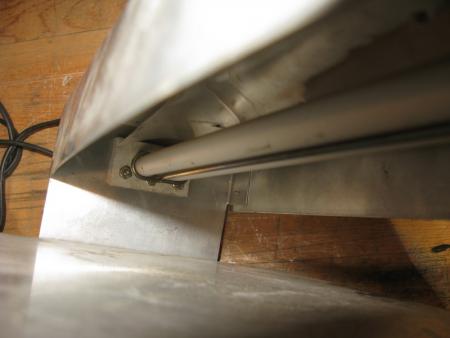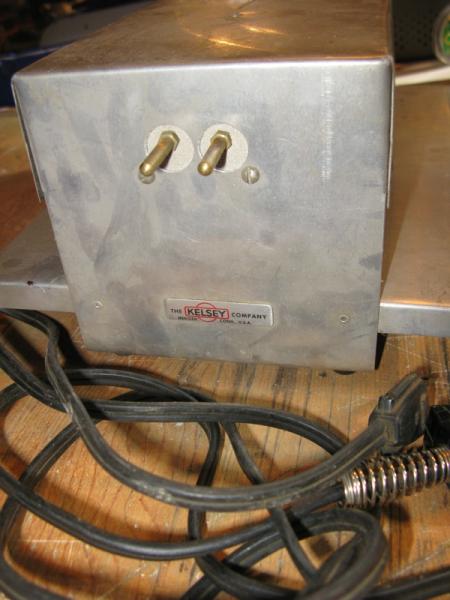Help Identifying a Kelsey Company Heating Device
I wonder if anyone can identify this piece of heating equipment from Kelsey Company. It came along with some letterpress equipment I purchased at a liquidation but no one there knew what it was.
Does anyone recognize it? I am guessing it has something to do with embossing or stamping. Thanks!

kelsey 3.jpg

kelsey 1.jpg

kelsey 2.jpg
thats a kelsey raised printing machine, have the same one, you dust the printed sheet while the ink is wet, then shake off the excess raising powder then hold it under the heater till the powder melts and the image is raised.
Ok,
That makes sense although I would never have guessed it! Thanks.
Sounds like the prototype for a laser printer or photocopier…
Kelsey sold these units for quite a few years, ranging in price from $18.00 to about $45 over the years. One of their later catalogues (c.1980) advertises that the machine has “for efficiency, an asbestos lining with a bright finish reflector.” So ‘caveat emptor!’ There might be asbestos issues with your unit. Other than the health-danger problems these units were efficient enough for small runs and hobby printing and deliverd the right amount of heat for the thermographic powder to ‘raise’ the printed surface and let the customer imagine that they were getting ‘engraved’ printing. As I said, ‘Caveat emptor!’
It’s basically a toaster oven which heats the added thermographic powder until it expands giving the look of embossing without the actual effort. It was quite popular in the 80s, but I haven’t heard much about it for a while.
@emthree Quite a different type of machine. As the Kelsey catalogue warned “This machine is NOT a press but is used with a press.” Apparently some Kelsey clients were confused and Kelsey felt the need to clarify how the raised printing unit worked and what it produced, i.e. printing that stood up on the page as if it had been engraved. The difference is that the raised printing process raises the printed letter without indenting the reverse side. True engraving both raises the printed letter and leaves an indented “expression” on the reverse side of the printed page.
dcrnkovic, doesn’t photocopier/laser printer technology use heat to make toner adhere to the image areas, similarly to this process?
No. The only thing similar is heat.
To all
Something happened to my previous post.
I am not an expert on this.
In 1957, I saw a method of producing business cards somewhat similar to what is described here. It was called Vercotype or Virkotype. described as a cheap substitute for embossed printing.
It occurs to me that someone could experiment, to find out if it could be used for drying ink on letterpress printing, if that is a problem with some kinds of ink/paper?
Alan.
i own a commercial thermography machine, i printed labels that were on a metalic stock then they had to be die cut, the ink was still wet after 3 days so i ran them thru the machine and raised them, if i didn’t do this the ink would never have dried so i could die cut them. sometimes it changes the color a little and maybe the customer doesn’t like the letters raised up.
I thought you might be amused by an original listing from the 1946 Kelsey catalog. I found this catalog (I think) in the Internet Archive www.archive.org
Enjoy
1946Kelseypg30.jpg
I’ll have a large with pepperoni, to go.
René Treumann from Typique in Amsterdam showed me how do achieve the raised effect with the resin powder and a DIY paint stripper. No need at all for any fancy machines… Print, apply the powder, shake off the excess and switch on the paint stripper in its lowest position.
i have used a heat gun for a short run. Once i pulled a proof of an invitation with black ink and dusted it with gold powder, it raised gold, tried silver powder and got a really good silver, i think you can get other colors of powder also.
Not an ideal solution, but lacking paint strippers and heat guns, I’ve gotten acceptable results with a flatiron and a pair of chopsticks to hold it above the surface.
/ducks and covers
I’ve used a simple coil-style hotplate to the same effect as the iron and heat gun. Any moderate heat source will work, but they all have their dangers!
Little Acorn, Interestingly the later Kelsey catalogues that I own have the exact same advertisement - only with the price removed! If I recall, the cost by c. 1980 was around $40-$45.